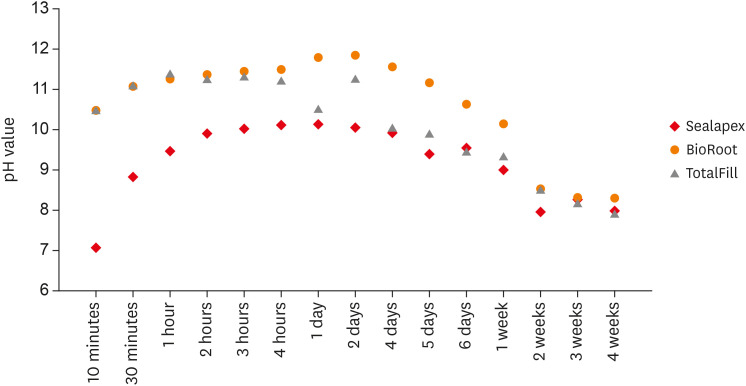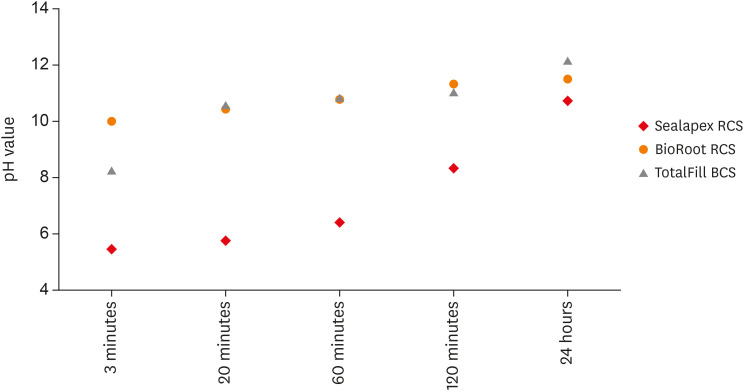1. Schilder H. Filling root canals in three dimensions. 1967. J Endod. 2006; 32:281–290. PMID:
16554195.
2. Gopikrishna V, Suresh Chandra B. Grossman's endodontic practice. 13th ed. New Delhi: Wolters Kluwer India;2018.
3. Orstavik D. Essential endodontology. 3rd ed. Hoboken, NJ: Wiley Blackwell;2020.
4. Donnermeyer D, Bürklein S, Dammaschke T, Schäfer E. Endodontic sealers based on calcium silicates: a systematic review. Odontology. 2019; 107:421–436. PMID:
30554288.

5. Al-Haddad A, Che Ab Aziz ZA. Bioceramic-based root canal sealers: a review. Int J Biomater. 2016; 2016:9753210. PMID:
27242904.
6. Siboni F, Taddei P, Zamparini F, Prati C, Gandolfi MG. Properties of BioRoot RCS, a tricalcium silicate endodontic sealer modified with povidone and polycarboxylate. Int Endod J. 2017; 50(Suppl 2):e120–e136. PMID:
28881478.
7. da Silva LA, Leonardo MR, da Silva RS, Assed S, Guimarães LF. Calcium hydroxide root canal sealers: evaluation of pH, calcium ion concentration and conductivity. Int Endod J. 1997; 30:205–209. PMID:
9477806.

8. Urban K, Neuhaus J, Donnermeyer D, Schäfer E, Dammaschke T. Solubility and pH value of 3 different root canal sealers: a long-term investigation. J Endod. 2018; 44:1736–1740. PMID:
30243663.

9. Colombo M, Poggio C, Dagna A, Meravini MV, Riva P, Trovati F, Pietrocola G. Biological and physico-chemical properties of new root canal sealers. J Clin Exp Dent. 2018; 10:e120–e126. PMID:
29670728.

10. Poggio C, Dagna A, Ceci M, Meravini MV, Colombo M, Pietrocola G. Solubility and pH of bioceramic root canal sealers: a comparative study. J Clin Exp Dent. 2017; 9:e1189–e1194. PMID:
29167707.

11. International Standards Organization. Dentistry - root canal sealing materials (ISO 6876:2012). Geneva: ISO;2012.
12. Zhou HM, Shen Y, Zheng W, Li L, Zheng YF, Haapasalo M. Physical properties of 5 root canal sealers. J Endod. 2013; 39:1281–1286. PMID:
24041392.

13. Song YS, Choi Y, Lim MJ, Yu MK, Hong CU, Lee KW, Min KS.
In vitro evaluation of a newly produced resin-based endodontic sealer. Restor Dent Endod. 2016; 41:189–195. PMID:
27508160.

14. Lim ES, Park YB, Kwon YS, Shon WJ, Lee KW, Min KS. Physical properties and biocompatibility of an injectable calcium-silicate-based root canal sealer:
in vitro and
in vivo study. BMC Oral Health. 2015; 15:129. PMID:
26490372.
15. Candeiro GT, Correia FC, Duarte MA, Ribeiro-Siqueira DC, Gavini G. Evaluation of radiopacity, pH, release of calcium ions, and flow of a bioceramic root canal sealer. J Endod. 2012; 38:842–845. PMID:
22595123.

16. Brackett MG, Marshall A, Lockwood PE, Lewis JB, Messer RL, Bouillaguet S, Wataha JC. Cytotoxicity of endodontic materials over 6-weeks
ex vivo
. Int Endod J. 2008; 41:1072–1078. PMID:
19133096.
17. Scarparo RK, Grecca FS, Fachin EV. Analysis of tissue reactions to methacrylate resin-based, epoxy resin-based, and zinc oxide-eugenol endodontic sealers. J Endod. 2009; 35:229–232. PMID:
19166779.

18. Lee JK, Kwak SW, Ha JH, Lee W, Kim HC. Physicochemical properties of epoxy resin-based and bioceramic-based root canal sealers. Bioinorg Chem Appl. 2017; 2017:2582849. PMID:
28210204.

19. Vertuan GC, Duarte MA, Moraes IG, Piazza B, Vasconcelos BC, Alcalde MP, Vivan RR. Evaluation of physicochemical properties of a new root canal sealer. J Endod. 2018; 44:501–505. PMID:
29254816.

20. Khalil I, Naaman A, Camilleri J. Properties of tricalcium silicate sealers. J Endod. 2016; 42:1529–1535. PMID:
27523906.

21. Tanomaru-Filho M, Torres FF, Chávez-Andrade GM, de Almeida M, Navarro LG, Steier L, Guerreiro-Tanomaru JM. Physicochemical properties and volumetric change of silicone/bioactive glass and calcium silicate-based endodontic sealers. J Endod. 2017; 43:2097–2101. PMID:
29032816.

22. Chang SW, Lee YK, Zhu Q, Shon WJ, Lee WC, Kum KY, Baek SH, Lee IB, Lim BS, Bae KS. Comparison of the rheological properties of four root canal sealers. Int J Oral Sci. 2015; 7:56–61. PMID:
25059248.

23. Almeida JF, Gomes BP, Ferraz CC, Souza-Filho FJ, Zaia AA. Filling of artificial lateral canals and microleakage and flow of five endodontic sealers. Int Endod J. 2007; 40:692–699. PMID:
17608677.

24. Silva EJ, Rosa TP, Herrera DR, Jacinto RC, Gomes BP, Zaia AA. Evaluation of cytotoxicity and physicochemical properties of calcium silicate-based endodontic sealer MTA Fillapex. J Endod. 2013; 39:274–277. PMID:
23321245.

25. Vitti RP, Prati C, Silva EJ, Sinhoreti MA, Zanchi CH, de Souza e Silva MG, Ogliari FA, Piva E, Gandolfi MG. Physical properties of MTA Fillapex sealer. J Endod. 2013; 39:915–918. PMID:
23791263.

26. American National Standards Institute/American Dental Association. ANSI/ADA specification No. 57 for endodontic filling materials. Washington, D.C.: ANSI;2000.
27. Marín-Bauza GA, Silva-Sousa YT, da Cunha SA, Rached-Junior FJ, Bonetti-Filho I, Sousa-Neto MD, Miranda CE. Physicochemical properties of endodontic sealers of different bases. J Appl Oral Sci. 2012; 20:455–461. PMID:
23032208.

28. Reddi BA. Why is saline so acidic (and does it really matter?). Int J Med Sci. 2013; 10:747–750. PMID:
23630439.

29. Zamparini F, Siboni F, Prati C, Taddei P, Gandolfi MG. Properties of calcium silicate-monobasic calcium phosphate materials for endodontics containing tantalum pentoxide and zirconium oxide. Clin Oral Investig. 2019; 23:445–457.

30. Duarte MA, Demarchi AC, Giaxa MH, Kuga MC, Fraga SC, de Souza LC. Evaluation of pH and calcium ion release of three root canal sealers. J Endod. 2000; 26:389–390. PMID:
11199761.

31. Eldeniz AU, Erdemir A, Kurtoglu F, Esener T. Evaluation of pH and calcium ion release of Acroseal sealer in comparison with Apexit and Sealapex sealers. Oral Surg Oral Med Oral Pathol Oral Radiol Endod. 2007; 103:e86–e91.

32. Siqueira JF Jr, Fraga RC, Garcia PF. Evaluation of sealing ability, pH and flow rate of three calcium hydroxide-based sealers. Endod Dent Traumatol. 1995; 11:225–228. PMID:
8625936.

33. Faria-Júnior NB, Tanomaru-Filho M, Berbert FL, Guerreiro-Tanomaru JM. Antibiofilm activity, pH and solubility of endodontic sealers. Int Endod J. 2013; 46:755–762. PMID:
23441819.

34. Santos AD, Moraes JC, Araújo EB, Yukimitu K, Valério Filho WV. Physico-chemical properties of MTA and a novel experimental cement. Int Endod J. 2005; 38:443–447. PMID:
15946264.

35. McHugh CP, Zhang P, Michalek S, Eleazer PD. pH required to kill Enterococcus faecalis
in vitro
. J Endod. 2004; 30:218–219. PMID:
15085049.
36. Okabe T, Sakamoto M, Takeuchi H, Matsushima K. Effects of pH on mineralization ability of human dental pulp cells. J Endod. 2006; 32:198–201. PMID:
16500225.

37. Stuart CH, Schwartz SA, Beeson TJ, Owatz CB. Enterococcus faecalis: its role in root canal treatment failure and current concepts in retreatment. J Endod. 2006; 32:93–98. PMID:
16427453.

38. Stock CJ. Calcium hydroxide: root resorption and perio-endo lesions. Br Dent J. 1985; 158:325–334. PMID:
3859315.







 PDF
PDF Citation
Citation Print
Print





 XML Download
XML Download